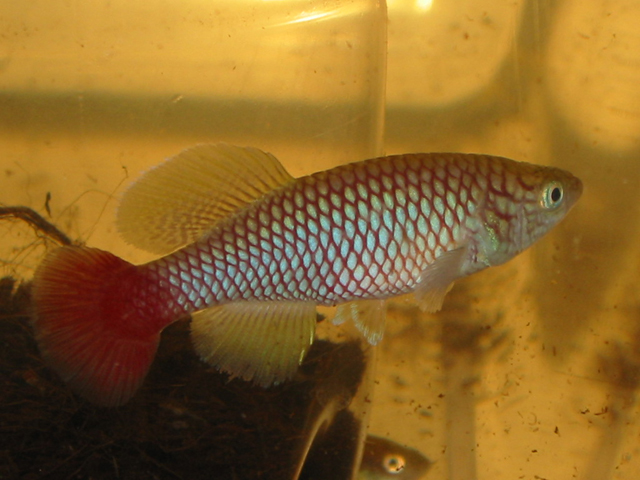|
Dorsal spines (total): 0-0; Dorsal soft rays (total): 14-17; Anal spines: 0-0; Anal soft rays: 13-19. Diagnosis: Nothobranchius makondorum males are distinguished from those of the related N. melanospilus and N. lucius by a complete black margin around the red caudal fin vs. plain red caudal fin with a narrow black margin at the upper and lower corners in N. melanospilus, red-brown and orange-red with broad black margin in N. lucius, and light blue iris vs. silver in N. melanospilus; females are distinguished from those of N. melanospilus and N. lucius by grey spots on the sides vs. black in N. melanospilus, brown in N. lucius, and absence of spots on the head and unpaired fins vs. spotted unpaired fins in N. melanospilus and spotted head and unpaired fins in N. lucius (Ref. 83514). Description: A species of Nothobranchius of relatively large size (Ref. 83514). Snout rounded, mouth subterminal, directed upward; dorsal profile slightly concave on head, concave from nape to end of dorsal fin; caudal peduncle profile straight at upper and lower sides (Ref. 83514). Dorsal-fin rays 14-17; anal-fin rays 13-19; relative position of base of first dorsal-fin ray over base of anal-fin ray 1 or 2; pelvic fin short, not reaching first anal-fin rays; pectoral fin reaching to first pelvic-fin rays (Ref. 83514). Scales on median longitudinal line 29-34 + 4-6 on caudal-fin base, most with shallow pit in center with one neuromast; transverse row of scales above pelvic fin 11-14; scales around caudal peduncle 15-16 (Ref. 83514). Supra-orbital squamation variable, but G-type in most specimens; anterior part of supra-orbital squamation partly covered with epidermal tissue; central supra-orbital neuromast system in two distinct, shallow grooves, both lined with three shallow lobes on both sides; posterior cephalic neuromast system in two curved pits (Ref. 83514). Colouration: colouration of live male: body and anterior part of caudal fin light blue, abdomen white to pale blue, back brown; posterior margin of scales red to red-brown; width of margin variable at population level resulting in dominantly red or blue populations; on posterior part of body and caudal peduncle margin may, in some populations, be wider than on scales of anterior part, forming a chevron pattern, apex to rear; operculum with three red-brown oblique stripes; throat red; projecting part of branchiostegal membrane red with narrow white margin; iris light blue; posterior part of caudal peduncle and caudal fin bright red; caudal fin with grey to black margin; dorsal fin light blue-green with irregular red to red-brown stripes and spots, latter becoming denser towards distal edge; narrow light blue to white margin present in some specimens; anal fin light blue-green, with some red to red-brown spots at base; a narrow light blue to white margin present in some specimens; some populations with red anal fin and light blue markings at base; pelvic fin similar to anal fin; pectoral fin pale pink to colourless with white posterior margin (Ref. 83514). Colouration of live female: body grey-brown, darker on back and lighter on abdomen; scales on anterior part of body with light blue centers; scales on posterior part of body and caudal fin usually with small grey spots, usually forming rearward-pointing chevron pattern; specimens without body markings may be found in some populations; all fins colourless; iris silver (Ref. 83514). |
| Annual species; found in water-filled depressions on the floodplain of rivers and creeks or remnant pools of seasonal creeks; water in all pools turbid; during dry season, pools mostly dry up; usually no aquatic vegetation, but grasses may be present only at the margins of the water bodies; if aquatic vegetation is present, it may include Nymphea, Ottelia, Lagarosiphon, and Utricularia species; no associated fish species were observed (Ref. 83514). |

